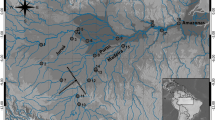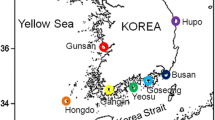Abstract
The mitochondrial cytochrome b gene was amplified by PCR and sequenced directly in 21 shearwaters and 14 gulls. Within the monophyletic herring gull complex which is closely related and of recent origin, the Mediterranean herring gull (L. cachinnans) appears to be genetically distinct, thus confirming our preliminary study (Wink et al., 1994). The genetic speciation ofP. puffinus andP. yelkouan (Wink et al., 1993b) was also corroborated. Within theCalonectris diomedea-complex, the existence of at least three different maternal lineages became obvious besides a genetic differentiation between the 2 subspeciesC. d. diomedea andC. d. borealis, a pair of maternal lines was found within theC. d. diomedea group. Since birds belonging to one of these 2 maternal lineages were found in 3 to 5 of the mediterranean populations, a dispersion of female shearwaters throughout the range is suggested.
Zusammenfassung
Das Cytochrom b-Gen von 3 Arten des Großmöwenkomplexes (Silber-, Herings- und Weißkopfmöwe) und 4 Arten europäischer Sturmtaucher (Eissturmvogel, Schwarzschnabel-, Mittelmeer- und Gelbschnabelsturmtaucher) wurde amplifiziert und sequenziert. Die phylogenetische Analyse mittels Maximun Parsimony und Neighbour-Joining bestätigte im wesentlichen die Aussagen von Voruntersuchungen mit einem kleineren, 300 Basenpaaren langen Teilstück des Cytochrom b-Gens (Wink et al., 1933 a,b, 1994): Die Weißkopfmöwe (Larus cachinnans) läßt sich molekulargenetisch von Silber- und Heringsmöwe abtrennen und kann als eigene Art angesehen werden, wenn man diesen Status auch der Silber- und Heringsmöwe einräumt. Alle 3 Arten stammen von einer gemeinsamen Vorläuferart ab, wobei die Trennung vor maximal 0,3–0,4 Mio. Jahren erfolgt sein dürfte. In der Gruppe der europäischen Sturmtaucher lassen sichP.puffinus, P.yelkouan undC. diomedea als eigenständige Arten abgrenzen. Innerhalb des Gelbschnabelsturmtaucherkomplexes, findet man mindestens 3 Gruppen von maternalen Linien, von denen 2 der UnterartC. d. diomedea und 1 der UnterartC. d. borealis zuzuordnen sind. Eine populationsspezifische Zuordnung der Haplotypen innerhalb der Mittelmeerunterart ist nicht möglich, so daß davon ausgegangen werden muß, daß die Mittelmeerpopulationen untereinander im Genaustausch stehen.
Similar content being viewed by others
Literatur
Avise, J. C. (1989): Gene trees and organismal histories: A phylogenetic approach to population biology. Evolution 43: 1192–1208.
Avise, A. J. (1994): Molecular markers, natural history and evolution. N. Y.
Blechschmidt, K., H. U. Peter, J. de Korte, M. Wink, I. Seibold &A. Helbig (1993): Untersuchungen zur molekularen Systematik von Raubmöwen (Stercorariidae). Zool. Jb. Syst. 120: 379–387.
Bourne, W. R. P., E. J. Mackrill, A. M. Paterson &P. Yesou, (1988): The Yelkouan shearwater:Puffinus (puffinus?)yelkouan. Brit. Birds 81: 306–319.
Cooper, A., C. Mourer-Chauvire, G. K. Chambers, A. von Haeseler, A. Wilson &S. Pääbo (1992): Independent origin of New Zealand Moas and Kiwis. Proc. Natl. Acad. Sci. USA 89: 8741–8744.
Cracraft, J. (1983): Species concepts and speciation analysis. Curr. Ornithol. 1: 159–187.
Doyle, J. J. (1993): DNA, phylogeny, and the flowering of plant systematics. BioSci. 43: 380–389.
Edwards, S. V., P. Arctander &A. C. Wilson (1991): Mitochondrial resolution of a deep branch in the genealogical tree for perching birds. Proc. Roy. Soc. Lond. B. Biol. Sci. 243: 99–107.
Glutz von Blotzheim, U., U. N. Bauer &E. Bezzel (1982): Handbuch der Vögel Mitteleuropas. Bd. 8. Wiesbaden.
Griesebach, L. H., &L. Brouillet (1994): Are many plant species polyphyletic?. Taxon 43: 21–32.
Haffer, J. (1988): Ornithologists and species concepts. Proc. Int. 100. DOG Meeting, Bonn: 57–60.
Heidrich, P., &M. Wink (1994): Tawny owl (Strix aluco) and Hume's Owl (Strix butleri) are distinct species: Evidence from nucleotide sequences of the cytochrome-b gene. Z. Naturforsch. 49c: 230–234.
Heidrich, P., C. König &M. Wink (1995): Molecular phylogeny of the South AmericanOtus atricapillus complex (Aves Strigidae) inferred from nucleotide sequences of the mitochondrial cytochrome-b gene. Z. Naturforsch 50c: 294–302.
Helbig, A. (1994): Genetische Differenzierung von Möwen und Sturmtauchern: Ein Kommentar. J. Orn. 135: 609–615.
Helbig, A. J., M. Salomon, M. Wink &J. Bried (1993): Absence of mitochondrial gene flow between European and Iberian „chiffchaffs“ (Phylloscopus collybita collybita, P. (c.)brehmii). The taxonomic consequences. Results drawn from PCR and DNA sequencing. Compt. Rend. l'Acad. Sci. Paris 316: 205–210.
Helbig, A. J., I. Seibold, J. Martens &M. Wink (1995): Genetic differentiation and phylogenetic relationships of Bonelli's warbler (Phylloscopus bonelli) and Green Warbler (P. nitidus). J. Avian Biol. 26: 139–153.
Helm-Bychowski, K., &J. Cracraft (1993): Recovering phylogenetic signal from DNA-sequences: relationships within the mitochondrial DNA cytochrome-b gene. Mol. Biol. Evol. 10: 1196–1214.
Hillis, D. M., &C. Moritz (1990): Molecular systematics. Sunderland.
Hoelzel, A. R. (1992): Molecular genetic analysis of populations. IRL-Press, Oxford.
Hoss, M., O. Handt &S. Pääbo (1994): Recreating the past by PCR. InK. B. Mullis, F. Ferre, &R. A. Gibbs, PCR: The polymerase chain reaction: 257–264. Basel.
Janke, A., G. Feldmaier-Fuchs, W. K. Thomas, A. von Haeseler &S. Pääbo (1994): The marsupial mitochondrial genome and the evolution of placental mammals. Genetics 137: 243–256.
Kocher, T. D., W. K. Thomas, A. Meyer, S. V. Edwards, S. Pääbo, F. X. Villablanca &A. C. Wilson (1989): Dynamics of mitochondrial DNA evolution in animals: amplification and sequencing with conserved primers. Proc. Natl. Acad. Sci. USA 86: 6196–6200.
Kornegay, J. R., T. D. Kocher, L. A. Williams &A. C. Wilson (1993). Pathways of lysozyme evolution inferred from sequences of cytochrome-b in birds. J. Mol. Evol. 37: 367–379.
Kumar, S., K. Tamura &M. Nei (1993): MEGA: Molecular evolutionary genetics analysis. Pennsylvania State University.
Krajewski, C., &A. W. Dickerman (1990): Bootstrap analysis of phylogenetic trees derived from DNA hybridisation distances. Syst. Zool. 39: 383–390.
Krajewski, C., &J. W. Fetzner (1994): Phylogeny of cranes (Gruiformes: Gruidae) based on cytochrome-b DNA sequences. Auk, 111: 351–365.
Lovalvo, M. &B. Massa (1988): Considerations on a specimen of Cory's shearwater ringed at Selvagem Grande and recovered in the Central Mediterranean. Bocagiana 69: 1–5.
Mallet, J. (1995): A species definition for the Modern Synthesis. Trends in Ecology and Evolution 10, 294–298.
McKitrick, M., &R. M. Zink (1988): Species concepts in ornithology. Condor 90: 1–14.
Mullis, K. B., &F. A. Falcoona (1987): Specific synthesis in vitro via a polymerase catylzed chain reaction. Meth. Enzymol. 155: 335–350.
Pääbo, S., R. G. Higuchi &A. C. Wilson (1989): Ancient DNA and the polymerase chain reaction, the emerging field of molecular archaeology. J. Biol. Chem. 264: 9709–9712.
Richman, A. D., &T. Price (1992): Evolution of ecological differences in the Old World leaf warblers. Nature 355: 817–821.
Saiki, R. K., D. H. Gelfand, S. Stoffel, S. J. Scharf, R. Higuchi, G. T. Horn, K. B. Mullis, &H. A. Erlich (1988): Primer directed enzymatic amplification of DNA with a thermostable DNA polymerase. Science 239: 487–491.
Seibold, I., A. J. Helbig &M. Wink (1993): Molecular systematics of falcons (family Falconidae). Naturwiss. 80: 87–90.
Seibold, I., A. J. Helbig, B. U. Meyburg, J. J. Negro &M. Wink (1995): Genetic differentiation and molecular phylogeny of European Aquila eagles (Aves: Falconiformes) according to cytochrome-b nucleotide sequences. Eagle Studies (im Druck).
Sibley, C. G., &J. E. Ahlquist (1990): Phylogeny and classification of birds. A study in molecular evolution. New Haven.
Snell, R. R. (1992): Interspecific allozyme differentiation among north atlantic white — headed Larid gulls. Auk 108: 319–328.
Stewart, C. B. (1993): The powers and pitfalls of parsimony. Nature 361: 603–607.
Swofford, D. L. (1991): PAUP: Phylogenetic analysis using parsimony, Version 3.0s. Illinois Natural History Survey, Champaign.
Urich, K. (1990). Vergleichende Biochemie der Tiere. Stuttgart.
Wenink, P. W., A. J. Baker &M. G. J. Tilanus (1993): Hypervariable control region sequences reveal global population structuring in a long-distance migrant shorebird, the dunlin. Proc. Natl. Acad. Sci, USA, 90: 94–98.
Willmann, R. (1985) Die Art in Raum und Zeit. Hamburg.
Wilson, A. C., H. Ochman, &E. M. Prager (1987): Molecular time scale for evolution. Trends Genetics 3: 241–247.
Wink, M. (1994): PCR in der Evolutionsforschung. In:M. Wink &H. Wehrle, PCR im medizinischen und biologischen Labor: 166–184. Darmstadt.
Ders. (1995): Phylogeny of Old and New World vultures (Aves: Accipitridae and Cathardidae) inferred from nucleotide sequences of the mitochondrial cytochrome-b gene. Z. Naturforsch. (im Druck).
Wink, M., P. Heidrich, U. Kahl, I. Swatscheck, H.-H. Witt &T. Ristow (1993a): Inter- and intraspecific variation of the nucleotide sequence of the cytochrome-b gene in Cory's (Calonectris diomedea), Manx shearwater (Puffinus puffinus) and the Fulmar (Fulmarus glacialis). Z. Naturforsch. 48c: 504–509.
Wink, M., P. Heidrich &D. Ristow (1993b): Genetic evidence for speciation of the Manx shearwater (Puffinus puffinus) and the Mediterranean shearwaterPuffinus yelkouan. Vogelwelt 114: 226–232.
Wink, M. U. Kahl, P. Heidrich (1994): Lassen sich Silber-, Weißkopf- und Heringsmöwe (Larus argentatus, L. cachinnans undL. fuscus) molekulargenetisch unterscheiden? J. Orn. 135: 73–80.
Wink, M., C. Wink, W. Scharlau, &D. Ristow (1987): Ortstreue und Genfluß bei Inselvogelarten: Eleonorenfalke und Gelbschnabelsturmtaucher. J. Orn. 128: 485–488.
Wittmann, U., P. Heidrich, M. Wink &E. Gwinner (1995): Speciation of the stonechat (Saxicola torquata) inferred from nucleotide sequences of the cytochrome b gene. J. Zool. Syst. & Evol. Res. 33: 116–122.
Author information
Authors and Affiliations
Rights and permissions
About this article
Cite this article
Heidrich, P., Ristow, D. & Wink, M. Differenzierung von Gelb- und Schwarzschnabelsturmtauchern (Calonectris diomedea, Puffinus puffinus, P. yelkouan) und Großmöwen des Silbermöwenkomplexes (Larus argentatus, L. fuscus, L. cachinnans). J Ornithol 137, 281–294 (1996). https://doi.org/10.1007/BF01651070
Published:
Issue Date:
DOI: https://doi.org/10.1007/BF01651070




